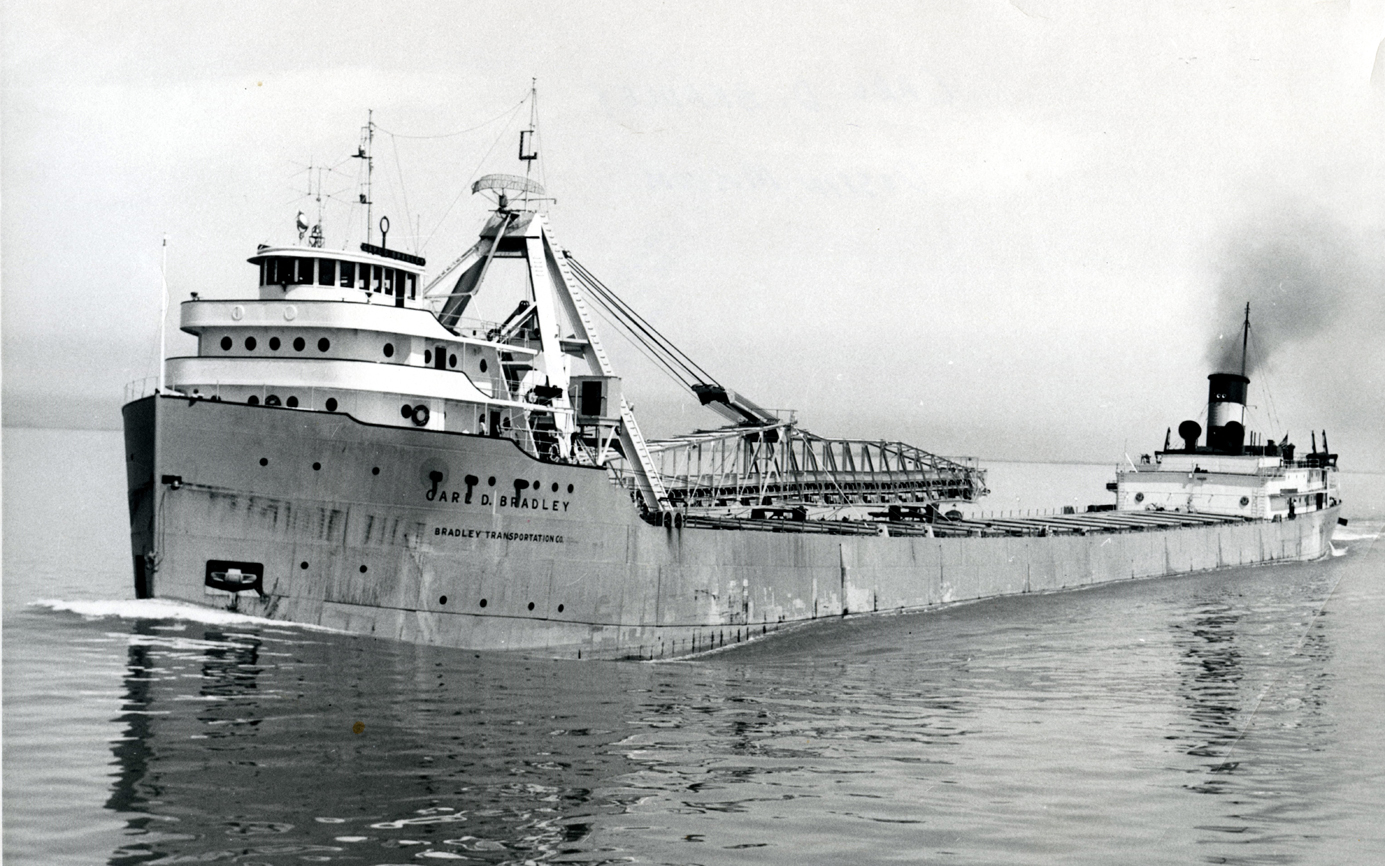
Survivor
Frank Mays was one of two survivors of the sinking of the Carl D. Bradley
By Patrick Sullivan | Nov. 10, 2018
The Carl D. Bradleywas headed to port in Manitowoc, Wisconsin on Nov. 18, 1958, to put in for the winter so that badly needed repairs to its rusty cargo hold could be completed.
The ship suddenly received orders to change course and head to its home port of Rogers City, Michigan, on Lake Huron. Its owner, U.S. Steel, had decided that the Bradleywould haul one last load of limestone that season.
It was a fateful decision. Gale force winds churned the lake as the east-bound freighter reached northern Lake Michigan. When the Bradleyattempted to navigate around the Beaver Island archipelago toward the Straits of Mackinac, it was battered by 40-foot waves. One of those waves cracked the ship in two and the boat quickly vanished into the lake.
Of the 35 people aboard, just two crewmen survived. Frank Mays and Elmer Fleming spent a freezing night on a raft before they were scooped up by a Coast Guard rescue boat the following morning, their bodies shrouded in ice.
The 639-foot self-unloader was at the time the longest vessel in the Great Lakes, but its steel hull, held together by rivets rather than welded together like more modern freighters were at the time, was desperately in need of repair. For years following the shipwreck, the families of the lost sailors believed that the Bradleywrecked because U.S. Steel had failed to maintain the boat. The company however always maintained the Bradleysunk intact and that its demise was an “act of God.”
Fleming died in 1969, but to this day Mays wants to keep the memory of the Bradleyalive. Although he lives in Florida, he returns to northern Michigan often to give presentations about his experience. He’s got one coming up at the Rogers City Theater on the 60thanniversary of the loss.
Mays is also promoting his book, “If We Make It ‘Til Daylight,” which gives his account of surviving the wreck.
Northern Express caught up with Mays in Florida via telephone. The interview is edited and condensed for clarity.
Northern Express: I understand you will be back in northern Michigan, in Rogers City, to give a talk on November 18, the anniversary of the sinking. What can people expect?
Frank Mays: I talk a little about [Nov. 18, 1958, the day the Carl Bradleywent down], but I don’t go too deep into it because, see, everything that had happened that night I put in my book called “If We Make It ‘Til Daylight.” I called the book that because that’s what I had said on the raft that night, ‘If we make it ‘til daylight, we will be found.’ And of course, four of us started out, but two of us made it to daylight.
Express: How did that day start out for you?
Mays: It was a regular normal day, but, see, all the details are in my book, and I don’t go too deep into that, because people who buy the book before I give my talk, that kind of gives away the plot. So, until a person asks me questions which I talk at the end, I tell them, ‘It’s in the book, see?’ So…
Express: So, if you don’t want to talk about that day, what about the years that followed. I understand that there was a lot of controversy over what caused the shipwreck, and this sort of pitted you against the Carl Bradley’s owner, U.S. Steel. You said you witnessed the boat snap in two, which would be evidence that the structure failed, while U.S. Steel claimed they found it in one piece at the bottom of Lake Michigan, which would indicate that the weather caused it to go down.
Mays: U.S. Steel, they got a ship called the Submarix, and they went out in 1959 with a hard hat diver to go down and take pictures of the Bradley, because they said they found her and they’ve got pictures of her and she’s in one piece. The message was: Elmer and I didn’t know what we saw. We were out of it or something. I don’t know how they could say something like that, because I was there, and I seen it. And then my attorney requested those pictures from U.S. Steel and they came back and said, ‘Well, we don’t know where they are.’
Express: But then later you took part in a dive and saw that the Bradleywas broken apart on the lake floor. That must have been some feeling, to be vindicated like that.
Mays: In 1997, I was out on an expedition and we had a remote operated vehicle to go down to the Bradleyand photograph the bow and the stern, two pieces on the bottom of Lake Michigan, 380 feet was the depth and the pieces were 120 feet apart. So, there was definite proof it was in two pieces, but it took that long to do this. There was a man by the name of Carl Vogelhiem who wrote a lot of articles for the local Rogers City paper, the Presque Isle County Advance, and he wrote this article after all these pictures were displayed, he said, ‘Now do you people believe Frank Mays and Elmer Fleming?’ U.S. Steel did a wonderful job of convincing the people that, no, it didn’t break in two, and we didn’t know what we saw.
Express: Did they embark on that disinformation campaign so that they wouldn’t have to take responsibility for the wreck?
Mays: Oh yes, definitely. They did all they could to do that. And they even had attorneys during all these hearings and Coast Guard meetings and inquiries. When I was in Cleveland in 1959, we were going through a lot of rigmarole with U.S. Steel, and I didn’t side with their attorneys. I got my own, and they indirectly fired me because of that. See, when the Bradleywent down, I had no intention of ever going back sailing again. And they told me, ‘You don’t have to go back. We’re going to give you a job on shore, shuffling paper, and you don’t have to go sailing.’ Well, when I didn’t cooperate with them, they came down the last work day of December 1959, and said to me, ‘If you want to work for U.S. Steel, you have to go back on the boats.’ That was their way of getting rid of me, which was the bitter part.
Express: What did you do?
Mays: The sweet part was, Medusa was building this new cement plant in Charlevoix, Michigan, and I sent an application in and they hired me and I was with them from ’67. I started with them, got a promotion while at that plant, and got another promotion and I was transferred to York, Pennsylvania. Medusa was the best company I ever worked for and I retired from them.
Express: Was U.S. Steel ever held appropriately responsible for the Bradleywreck, in your opinion?
Mays: U.S. Steel just pushed, pushed and pushed. They knew the Bradleywas in bad shape, because we were going into Manitowoc. We were done for the year for a new cargo hold to be put in, the ship re-strengthened. But it didn’t happen and now it’s rusting out there.
Express: Tell me about your book, “If We Make it 'Til Daylight.” How did that come about?
Mays: It came about by some people I knew who had what’s called Out of the Blue Productions. So, we got together and we started it. These are three school teachers down by Port Huron. They knew an English professor at Central Michigan in Mt. Pleasant who checked it, the language and everything. And then we just put it out and it sold.
Express: What did it mean to you to have your story out there in the form of a book?
Mays: It was great, because you see, U.S. Steel did a great job of killing it. My book came out … I believe it was in ’03. We went down in ’58 and U.S. Steel did a great job of killing it off, it just sort of died away and was just left dormant. It was interesting what U.S. Steel did to keep it quiet all those years. I was out of the picture then. I was out of town. I had moved away, and Elmer had passed away in ’69, so I was the only one left to tell the story. And that’s when I got together with these people and get this book out. Which we did. And I sell them, and I sign them, so if you’re interested, send me 20 bucks and I’ll sign it and I’ll send it to you. Go to Amazon and pay $50 for it and it’s not signed. Send me 20 bucks – it’s all you have to do – and the book is on its way to you.
Express: Do you see it as fortunate or unfortunate that Gordan Lightfoot never wrote an impossibly catchy folk song about the sinking of the Bradley?
Mays: Well, it’s unfortunate, but the song that he wrote about the Edmund Fitzgerald, the words are not true, you know? They’re made up words. It’s not a true song. The true song is the one [musician] Dan Hall wrote, it’s about Fleming and me, he recorded that and it’s on a CD.
To order a copy of “If We Make it 'Til Daylight,” send $20 to Frank Mays at 11031 Palamino Drive, Dade City, Florida, 33525.
Trending

Springtime Jazz with NMC
Award-winning vibraphonist Jim Cooper has been playing the vibraphone for over 45 years and has performed with jazz artist... Read More >>
Dark Skies and Bright Stars
You may know Emmet County is home to Headlands International Dark Sky Park, where uninterrupted Lake Michigan shoreline is... Read More >>
Community Impact Market
No need to drive through the orange barrels this weekend: Many of your favorite businesses from Traverse City’s majo... Read More >>


